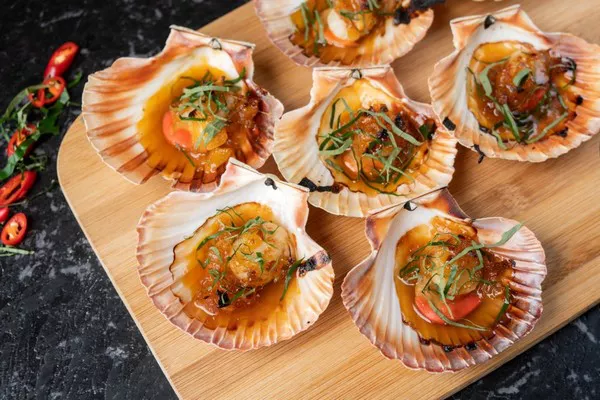Scallops, with their delicate sweetness and tender texture, are a prized ingredient that graces the tables of fine dining establishments and home kitchens alike. These succulent shellfish are a versatile canvas for culinary creativity, allowing cooks to showcase their skills and create unforgettable dishes. In this comprehensive guide, we explore the techniques, tips, and delectable recipes that will help you master the art of cooking scallops.
What are the types of scallops?
There are several types of scallops, each with its own characteristics and culinary uses. Here are some of the most common types of scallops:
1. Sea Scallops (Placopecten magellanicus): Sea scallops are the largest and most commonly consumed scallops. They have a sweet and delicate flavor, with a slightly firmer texture compared to smaller scallop varieties. Sea scallops are often used in a variety of cooking methods, including searing, grilling, baking, and poaching.
2. Bay Scallops (Argopecten irradians): Bay scallops are smaller and sweeter than sea scallops. They have a tender texture and are often used in dishes where a delicate presence is desired. Bay scallops are commonly found in estuaries and coastal bays, and they are often enjoyed in dishes like ceviche, pasta, and chowders.
3. Calico Scallops (Aequipecten gibbus): Calico scallops are smaller than sea scallops and are characterized by their shell’s intricate pattern of colors. They have a milder flavor and are often used in recipes where their appearance can be showcased, such as scallop shells for presentation.
4. Queen Scallops (Aequipecten opercularis): Queen scallops are small and tender, often found in European waters. They have a slightly sweeter taste compared to larger scallops and are popular in British and European cuisines.
5. Pacific (Patinopecten yessoensis) and Atlantic (Placopecten magellanicus) Deep-Sea Scallops: These scallops are harvested from deeper ocean waters and tend to have a sweeter, nuttier flavor. They are often larger and have a smoother texture than other scallop varieties.
6. Coral Scallops (Chlamys spp.): Coral scallops, also known as “red roe” scallops, are named for their bright red or orange roe (eggs). They are smaller in size and are often used for their roe, which is considered a delicacy in some cuisines.
7. Japanese Scallops (Mizuhopecten yessoensis): Japanese scallops are commonly found in the northern Pacific Ocean. They have a delicate, sweet flavor and are often enjoyed raw as sashimi or sushi.
How To Select the Perfect Scallops
Selecting the perfect scallops is crucial to ensure that your dish turns out delicious and flavorful. Here’s a guide to help you choose the best scallops:
1. Appearance: Look for scallops with a creamy or slightly pinkish hue. Avoid scallops that appear overly white, as this might indicate that they’ve been treated with chemicals to preserve their color.
2. Smell: Fresh scallops should have a clean and slightly briny ocean scent. Avoid scallops that have a strong fishy or ammonia-like odor, as this could be a sign of deterioration.
3. Texture: When you touch the scallops, they should feel slightly firm and moist. Avoid scallops that feel overly slimy or dry.
4. Sizing: Scallops are often categorized by size, such as U10, U20, 10/20, etc., which indicates how many scallops make up a pound. Generally, larger scallops are easier to sear and grill, while smaller ones are great for dishes like ceviche or pasta.
5. Shell Fragments: Inspect the scallops for any broken shell fragments. Ideally, the scallops should be free from any pieces of shell.
6. Dry vs. Wet: Dry scallops are not treated with preservatives and have a purer, natural taste. Wet scallops are treated with a solution that can affect their flavor and texture. Look for “dry” or “chemical-free” labels when purchasing scallops.
7. Frozen Scallops: If fresh scallops are not available, frozen scallops can be a good alternative. Choose frozen scallops that are individually quick-frozen (IQF) to prevent them from sticking together. Thaw frozen scallops in the refrigerator before cooking.
See Also: 6 Healthiest Shellfish & Their Health benefits
Preparing Scallops for Cooking
1. Rinse and Drain the Scallops: Give the scallops a quick rinse under cold running water to remove any residual sand or debris. Pat them dry gently with paper towels. Ensuring the scallops are dry before cooking is essential to achieve a good sear or grill marks.
2. Remove the Muscle (Optional): Some scallops have a small, tough muscle attached to the side. While this muscle is edible, it can be slightly chewy, so you may choose to remove it. To do so:
Hold the scallop with one hand.
Use your other hand to pinch the muscle where it’s attached to the scallop.
Gently pull the muscle away from the scallop. It should come off easily.
3. Season the Scallops: Season the scallops with a light sprinkle of salt and pepper on both sides. This enhances their natural flavor and prepares them for cooking. You can also add other seasonings, such as herbs, spices, or a rub, depending on your recipe.
Mastering Scallop Cooking Techniques
1. Pan-Seared Scallops
Pan-searing is a popular technique that results in scallops with a beautiful golden crust and a tender interior. To achieve perfect pan-seared scallops:
Heat a skillet over medium-high heat and add a high smoke-point oil (e.g., grapeseed oil).
Place the scallops in the skillet, ensuring they’re not overcrowded.
Sear the scallops for 1-2 minutes on each side until they develop a caramelized crust and a slightly translucent center.
2. Grilled Scallops
Grilling imparts a smoky flavor to scallops and adds a delightful char. Follow these steps for succulent grilled scallops:
Preheat the grill to medium-high heat.
Thread scallops onto skewers or place them directly on the grill grates.
Grill for about 2-3 minutes on each side until grill marks form and the scallops are opaque.
3. Baked Scallops
Baking scallops allows for easy preparation and a gentle cooking process that retains their natural sweetness:
Preheat the oven to 375°F (190°C).
Arrange scallops in a baking dish and drizzle with olive oil or melted butter.
Bake for 10-15 minutes until the scallops are opaque and cooked through.
4. Poached Scallops
Poaching scallops in a flavorful liquid ensures their tenderness and imparts a delicate taste. To poach scallops:
Bring a mixture of broth, white wine, or a poaching liquid of your choice to a gentle simmer.
Add the scallops and poach for 2-3 minutes until they turn opaque and are cooked through.
Sauces and Accompaniments to Elevate Scallops
Pairing scallops with complementary sauces and accompaniments enhances their flavors and elevates the dining experience:
1. Lemon Butter Sauce: A classic choice that adds brightness and richness to the scallops.
2. Beurre Blanc: A velvety white wine sauce that complements the delicate sweetness of scallops.
3. Citrus Salsa: Fresh citrus salsa provides a zesty contrast to the scallops’ richness.
4. Herb-Infused Oils: Drizzling herb-infused oils over scallops imparts aromatic complexity.
See Also: What to Serve with Scallops: A Culinary Guide
Common Mistakes to Avoid
1. Overcooking: Scallops can become rubbery if overcooked. Pay attention to cooking times and avoid prolonged cooking.
2. Crowding the Pan or Grill: Crowded cooking surfaces can hinder proper searing and result in uneven cooking.
3. Skipping the Pat-Dry Step: Excess moisture prevents proper browning and can lead to steaming rather than searing.
Delicious Scallop Recipes to Try
1. Lemon Butter Pan-Seared Scallops
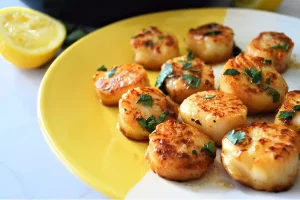
Ingredients:
Fresh scallops
Salt and pepper
Butter
Lemon juice
Fresh parsley
Instructions:
1. Season scallops with salt and pepper.
2. Heat butter in a skillet over medium-high heat.
3. Add scallops and sear for 1-2 minutes on each side.
4. Drizzle with lemon juice and garnish with parsley.
See Also: Lemon Butter Pan-Seared Scallops: Step-by-Step Tutorial
2. Garlic and Herb Grilled Scallops
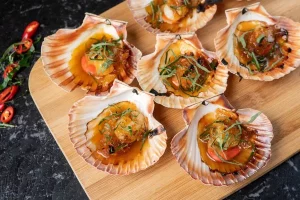
Ingredients:
Fresh scallops
Olive oil
Minced garlic
Chopped fresh herbs (e.g., thyme, rosemary)
Lemon zest
Instructions:
1. Toss scallops with olive oil, minced garlic, and herbs.
2. Thread scallops onto skewers and grill for 2-3 minutes on each side.
3. Sprinkle with lemon zest before serving.
3. Scallops with Champagne Sauce
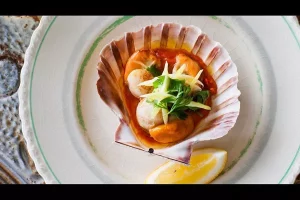
Ingredients:
Fresh scallops
Salt and pepper
Champagne or sparkling wine
Shallots
Heavy cream
Chopped chives
Instructions:
1. Season scallops with salt and pepper.
2. Sear scallops and set aside.
3. In the same pan, sauté shallots.
4. Deglaze with champagne and reduce.
5. Add cream and simmer until thickened.
6. Serve scallops with sauce and garnish with chives.
4. Creamy Parmesan Baked Scallops
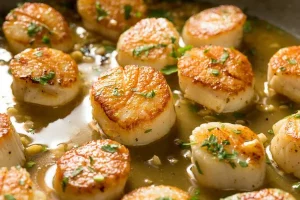
Ingredients:
Fresh scallops
Olive oil
Minced garlic
Grated Parmesan cheese
Bread crumbs
Fresh parsley
Instructions:
1. Arrange scallops in a baking dish.
2. Mix olive oil and minced garlic; drizzle over scallops.
3. Top with Parmesan cheese and bread crumbs.
4. Bake until golden and bubbly.
5. Garnish with chopped parsley.
5. Saffron-Infused Poached Scallops
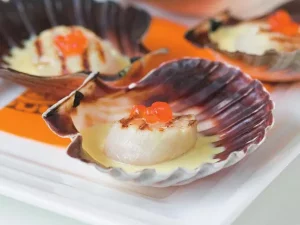
Ingredients:
Fresh scallops
Saffron threads
Warm water
White wine
Shallots
Butter
Lemon zest
Instructions:
1. Infuse saffron in warm water.
2. Poach scallops in a mixture of saffron water and white wine.
3. Sauté shallots in butter and drizzle over scallops.
4. Finish with lemon zest.
See Also: Pros & Cons of Eating Seafood Every Day
Pairing Wine with Scallops
Scallops’ delicate flavor pairs well with a variety of wines, enhancing the dining experience:
White Wines: Choose crisp and light whites like Sauvignon Blanc, Chardonnay, or Pinot Grigio.
Sparkling Wines: Champagne or sparkling wine adds a touch of elegance and effervescence.
See Also: Shelf Life of Seafood & How to Store It (Fresh+Cooked)
Savoring the Culinary Delight of Scallops
Cooking scallops is an art that allows you to create dishes that celebrate their natural sweetness and tender texture. Whether you prefer them pan-seared, grilled, baked, or poached, the key lies in selecting high-quality scallops, mastering the right techniques, and choosing complementary flavors. With the recipes and insights provided in this guide, you’ll be well-equipped to create culinary masterpieces that feature the captivating allure of scallops. So, roll up your sleeves, head to your kitchen, and embark on a journey of flavor, creativity, and pure indulgence with these exquisite shellfish.

